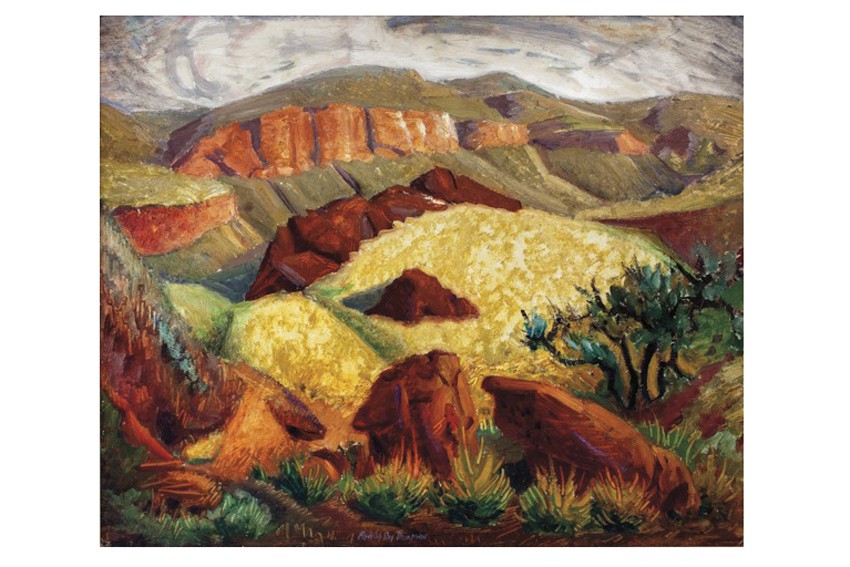The Art of Francis Roy Thompson: Vital Signs

Suddenly the last pieces of the Frank Roy (‘FR’) Thompson jigsaw are clicking into place. He is without doubt the berserker of post war Adelaide modernism.
Suddenly the last pieces of the Frank Roy (‘FR’) Thompson jigsaw are clicking into place. He is without doubt the berserker of post war Adelaide modernism. To add to the Viking spin, FR was renowned for his legendary dance of the shirt, tie and trousers at parties, which often resulted in one naked artist either clearing the room with ecstatic spins or heading off into the night. One account has the artist wandering nude, post-party, through the streets of Rose Park to his studio a few kilometres away. The next day found him calling out to a passersby to organise his clothes to be sent around, as he had no others to wear. Such antics confirmed a 1950s stereotypical image of the creative artist as a bohemian flouter of social conventions. Well, as we know from similar behaviour associated with the Adelaide Angries young contemporaries of the period, this Rabelaisian attitude to art and society was exactly what free spirits of the day needed to counteract the conservatism of mid-20th century tidy-town Adelaide. The remarkable thing, in Thompson’s instance, is that his origins and early promise as an artist were so conventional. A legacy of £500 from an uncle enabled the aspirant 18-year-old artist to enroll in the National Gallery Art School in Melbourne. Here he studied painting under Bernard Hall and drawing under WB McInnes. In 1922, his fifth year of studies, he was awarded the Hugh Ramsay Prize for portraiture. The imprint of his solid grounding in tonal illusionism, conventional composition and figurative drawing is evident in the early works in the Carrick Hill exhibition and in Adam Dutkiewicz’s recently published book, Francis Roy Thompson: Painter of Grace and Rebellion (Moon Arrow Press) which complements the exhibition. Thompson’s year of European travel after winning the Hugh Ramsay Prize exposed him to alternative modes of art, particularly Post Impressionism and Expressionism. As a result his paintwork became bolder and colours more luminous. Further travel and study in London in 1930 consolidated this journey to the brighter, expressionist side. Art critic for the Melbourne Herald, Basil Burdett was on the money when, in commenting on Thompson’s work in a 1938 exhibition, referred to Thompson’s “massive handling of colour and brilliance” as not only suggestive of van Gogh (one of Thompson’s favourite artists) but reminiscent of Sickert and the Camden Town painters. From the 1940s into the 1950s, a period that saw Thompson relocate from Melbourne to Adelaide, critical appreciation of his style continued to praise its vigour and assurance. Ivor Francis observed that his work was full of poetry. Thompson’s own assessment was that a “work should have Vitality, in fact an independent life of its own. The Art of painting is to animate a flat surface aesthetically. All else is simply an added interest.” The move to Adelaide had a number of benefits particularly the ease of access it offered to the Flinders Ranges and the Red Centre beyond. Flinders-related paintings are a feature of both the exhibition and book illustrations. In works including Rocky outcrop, The Grandeur, Flinders Ranges and Flinders Ranges landscape, the artist captures a tangible sense of compressed geological forces beneath a patina of weathered surfaces. Such works and other Alice Springs-related paintings deny the viewer conventional perspectives and atmospherics. The rich impastos offer instead a roller coaster ride of heaving brush marks and patterning. This intent to capture the muscular quality of topographies is also evident in other equally compelling landscapes, particularly Port Willunga and The valley, Belair. They have qualities of structural compression and raw-boned gesture one associates with the work of the mid-20th century British artist David Bomberg. The narrative Adam Dutkiewicz traces in his book provides a comprehensively researched and informative insight into the achievements of Thompson as a much-loved, much-travelled, talented, aspirational but flawed artist, who on a good day could blow everyone else off the walls with his take no prisoners approach to creating an image from inner conviction but who in his later years struggled for consistency and conviction in accommodating abstraction. All power to Carrick Hill for this opportunity to see so many rarely exhibited works and to Dutkeiwicz for self-publishing a landmark monograph which fills in significant gaps in the Adelaide modernist story and introduces Frank Roy Thompson to a wider audience than the inner circle of fans who have long appreciated his distinctive talents and contribution to Australian art. He was a man of good heart and great generosity who believed in making commitments. Grace and Rebellion: The Art of Francis Roy Thompson Carrick Hill Continues until Sunday, November 30 Francis Roy Thompson: Painter of Grace and Rebellion, Adam Dutkiewicz (Moon Arrow Press)